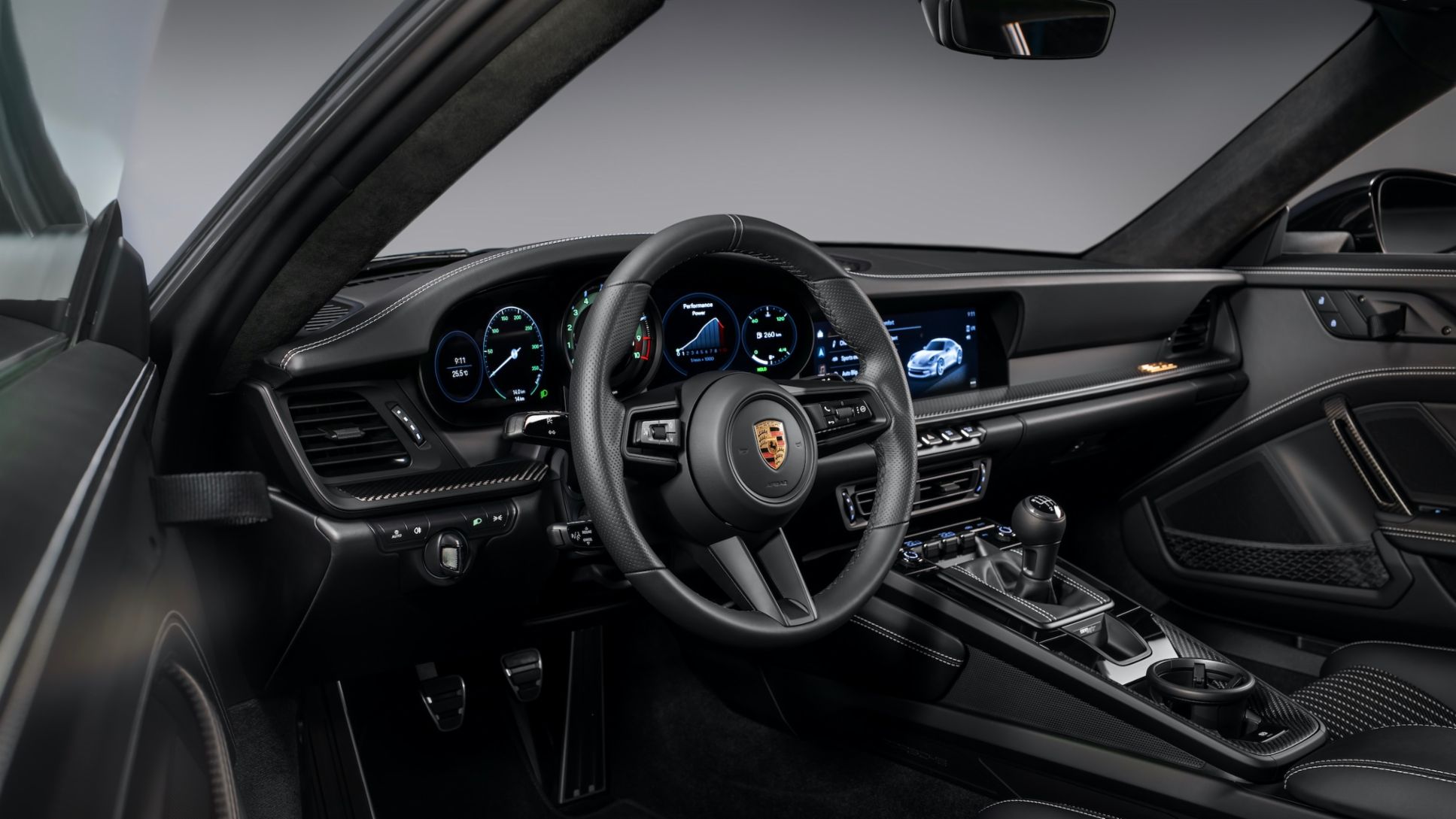Stripped-down, sporty exterior
Numerous references to 911 history and motorsport characterise the Porsche 911 S/T. The focus of its exterior design is on its dynamic and aerodynamic capabilities, which Porsche achieves here with a pared-down, purist approach. This emphasises the model’s character as a sports car designed for spirited driving on the roads. The omission of external design features of other, more track-focused, 911 GT models, in combination with the high-revving engine, is the standout feature of the 911 S/T. Porsche has also put together an exclusive colour selection: Black or White paint are available as standard, while customers have a choice of five optional colours – Ruby Star Neo, Gentian Blue Metallic, Shade Green Metallic, GT Silver Metallic and Ice Grey Metallic. There is also the Paint to Sample option as well as the Shore Blue Metallic colour of the Heritage Design Package.
The lightweight magnesium forged wheels were designed by Porsche with a central lock and wheel hub cover, which bears the ‘S/T’ logo. The wheels are 20 inches in diameter at the front and 21 inches at the rear. They are available in Matt Black, Brilliant Silver and Dark Silver.
The 911 S/T has a dark grey painted grille on the front, while a Silver Porsche logo down each side provides a sporty accent. At the rear of the 911 S/T, Porsche complements the retractable rear spoiler with an air intake grille in the colour of the front grille and a 60 years of 911 badge.
Compared to other sports cars in its performance class, the 911 S/T has been deliberately outfitted with subtle measures that ensure perfectly balanced aerodynamics. In contrast to the 911 GT3 RS, Porsche designed the car without wing-top wheel arch ventilation louvres, opting to ventilate the wheel arches with side blades instead.
A tear-off edge (Gurney flap) complements the retractable rear spoiler. Porsche regularly uses Gurney flaps to improve the aerodynamics of GT sports cars. This aerodynamic technology comes from American Indycar racing and refers to a tear-off edge or lip that is attached at an angle to the end of the spoiler wing. While Gurney flaps increase lift in aircraft at the bottom of the spoiler, they perform the opposite function in motor racing and on performance-focused road vehicles: mounted on the upper side of the spoiler, they increase the downforce and therefore the traction and grip of the vehicle by increasing the pressure on the top side of the edge and lowering it on the underside. In the 911 S/T, the tear-off edge works so efficiently that the spoiler only extends at 120 km/h and is not as steeply configured as in the sibling models. The spoiler retracts at a speed of 105 km/h.
Interior: Timeless style, exuberant performance
The interior of the 911 S/T provides the setting for the direct and exhilarating driving experience in the 911 S/T by stylishly combining purist equipment with sporty elegance. The standard interior door handle made of CFRP (carbon-weave finish) is normally only available in the 911 GT3 RS with the Weissach Package. Together with the textile door opener loop, it exemplifies the design principles of this special edition: both features are as much a traditional stylistic device as they are part of the lightweight concept of the vehicle. CFRP is also used for the door sill guards and the trim strips, in which a gold badge displays the build number of each 911 S/T. Porsche also builds the optionally available roll cage out of CFRP.
The 911 S/T features part-leather elements as standard. The quilted stitching provides a contrast in GT Silver. The green numerals on the instrument cluster and chrono timer as well as white hands with silver caps correspond to the design in the original 911 from 1963. The black leather cover of the steering wheel rim has a 12 o’clock marker as well as a particularly grippy perforation in the 3 o’clock and 9 o’clock positions. A shift lever shortened by about one centimetre and full bucket seats made of CFRP upholstered in part-leather guarantee a sporty yet safe driving experience. As an alternative to full bucket seats, four-way-adjustable Sports Seats are available at no extra charge. A Porsche crest embossed in the leather upholstery is featured on the headrests of both seat variants. In keeping with the consistent lightweight design concept, there are no rear seats in this model. In their place is a cover similar to the one in the interior of the 911 GT3 RS.

